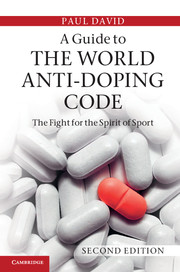Book contents
- Frontmatter
- Contents
- List of Figures
- Preface to the Second Edition
- Table of Cases
- Introduction
- 1 The development of principles relating to anti-doping regimes: the role of the Court of Arbitration for Sport
- 2 Overview of the Code and the World Anti-Doping Program
- 3 The International Standards in more detail
- 4 The nature of the Code and its interpretation and application
- 5 Articles 1 and 2 of the Code: anti-doping rule violations under the Code
- 6 Article 3 of the Code: the proof of anti-doping rule violations under the Code
- 7 Responsibility for testing and investigations, results management and hearings
- 8 Articles 9 and 10 of the Code: sanctions for anti-doping rule violations
- 9 Article 13: appeals under the Code
- 10 Appeals to the Swiss Supreme Court from CAS, challenges to the Code in the courts and claims outside the Code
- 11 The way ahead: review of the 2009 Code
- Index
- References
6 - Article 3 of the Code: the proof of anti-doping rule violations under the Code
Published online by Cambridge University Press: 05 February 2013
- Frontmatter
- Contents
- List of Figures
- Preface to the Second Edition
- Table of Cases
- Introduction
- 1 The development of principles relating to anti-doping regimes: the role of the Court of Arbitration for Sport
- 2 Overview of the Code and the World Anti-Doping Program
- 3 The International Standards in more detail
- 4 The nature of the Code and its interpretation and application
- 5 Articles 1 and 2 of the Code: anti-doping rule violations under the Code
- 6 Article 3 of the Code: the proof of anti-doping rule violations under the Code
- 7 Responsibility for testing and investigations, results management and hearings
- 8 Articles 9 and 10 of the Code: sanctions for anti-doping rule violations
- 9 Article 13: appeals under the Code
- 10 Appeals to the Swiss Supreme Court from CAS, challenges to the Code in the courts and claims outside the Code
- 11 The way ahead: review of the 2009 Code
- Index
- References
Summary
Introduction
Article 3.1 of the Code provides for both the burden and the standard of proof in proceedings before tribunals or CAS under the results management process which has to be implemented by anti-doping organisations under the Code. As has been outlined above, the proof of the violations contained in Articles 2.2 and 2.4–2.8 of the Code, will usually cover a wider range of factual circumstances and potentially probative evidential material, than will be the case with violations under Articles 2.1–2.3. In hearings involving the proof of violations under Articles 2.2 and 2.4–2.8, national and international tribunals and CAS, whether at first instance or on appeal, are more likely to be required to consider and assess a range of evidence on factual issues, as opposed to the more limited relevant evidence on whether a test result has been reached after following the proper process and is valid. In such hearings, there will inevitably be a greater focus on the application of the principles concerning the burden and standard of proof to the evidence presented in support of the alleged violations. The Code contains a number of provisions relating to the burden and standard of proof on anti-doping organisations and those against whom anti-doping rule violations are alleged, but is generally silent on questions of the admissibility of evidence. Such matters will be governed by the rules of the particular arbitral tribunal considering the question and any principles of law applicable under national law.
Burden on the anti-doping organisation
Article 3.1 provides that the burden of establishing that an anti-doping rule violation has occurred lies on the anti-doping organisation bringing the allegation. The organisation will have to establish the elements of the anti-doping rule violation alleged to have been committed. The process of proving an allegation will range from the presentation of the evidential material required to support an adverse analytical finding after sampling and analysis, to the proof of the factual matters required to establish a violation such as trafficking in a prohibited substance or method. Apart from the consideration of a violation under Article 2.1, the violations under the Code do not require an adverse analytical finding in relation to a bodily sample taken from the person against whom the allegation is made.
Information
- Type
- Chapter
- Information
- A Guide to the World Anti-Doping CodeA Fight for the Spirit of Sport, pp. 201 - 215Publisher: Cambridge University PressPrint publication year: 2013
